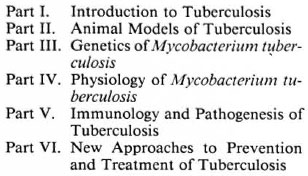- Volume 63 , Number 1
- Page: 122
Book reviews
Bloom, Barry R., ed. Tuberculosis; Pathogenesis, Protection, and Control. Herndon, Virginia: ASM Press, 1994. Hard copy, 653 pages, illustrations, index. List price US$72 (ASM Member price US$59) ISBN 1-55581-072-1. Order from ASM Press, P.O. Box 605, Herndon, VA 22070, U.S.A.
This often fatal disease persists as the largest cause of death from a single infectious agent. Dr. Bloom, a leading molecular biologist working on tuberculosis (TB), has gathered a team of acknowledged scientific and clinical experts from around the world to bring together the most current body of information on all aspects of TB-its global importance, epidemiology, molecular biology, and immunology. The authors discuss fundamental questions about the biology, genetics, mechanisms of pathogenicity, mechanisms of resistance, and drug development strategies that are likely to provide important new knowledge about TB and new interventions to prevent and treat this disease. Tuberculosis is necessary reading for scientists, clinicians, and public health officials concerned with the resurgence and spread of tuberculosis.
Condensed contents:

- ASM press release
Murray, C. J. L. and Lopez, A. D., eds. Global Comparative Assessments in the Health Sector; Disease Burden, Expenditures and Intervention Packages. Geneva: World Health Organization, 1994. Softbound, 196 pp., available in English (Spanish in preparation), US$18 (in developing countries, Sw.Fr. 14). ISBN 92 4 156175 0. Order from WHO, Distribution and Sales, 1211 Geneva 27, Switzerland.
The eight articles collected in this volume show how a new way of assessing the world health situation can be used to generate health data unprecedented in their completeness, comparability, and objectivity. Already recognized as capable of revolutionizing the processes of priority setting and resource allocation in the health sector, the approach was the first used to develop the empirical basis for the World Development Report 1993: Investing in Health. Nearly 100 disease experts collaborated in this project.
The book, which has two parts, discusses the methods, findings, and implications of the first comprehensive assessment of the global burden of disease, of the financial resources available to the health sector in every country, and of the options for costeffective interventions.
Articles in part one describe the concept, applications, and results of the use of disability-adjusted life years (DALYs) for measuring the global burden of disease. The indicator, which measures the time lived with a disability and the time lost due to premature mortality, has been used to estimate the burden of disease due to more than 100 causes, for five age groups, by sex, throughout the world. Detailed information is given on the technical basis of DALYs, global and regional cause-of-death patterns, methods for quantifying the health consequences of disabilities, and the main findings and implications of the global burden of disease approach.
Articles in part two provide comparative assessments of financial resources available to the health sector and the range of interventions that can be purchased with these resources. In a key achievement, these assessments allow identification of a minimum package of essential public health and clinical interventions, which are highly costeffective and capable of reducing the disease burden in low-income developing countries by about 25% at a cost of US$ 12 per person per year. - From WHO promotion piece